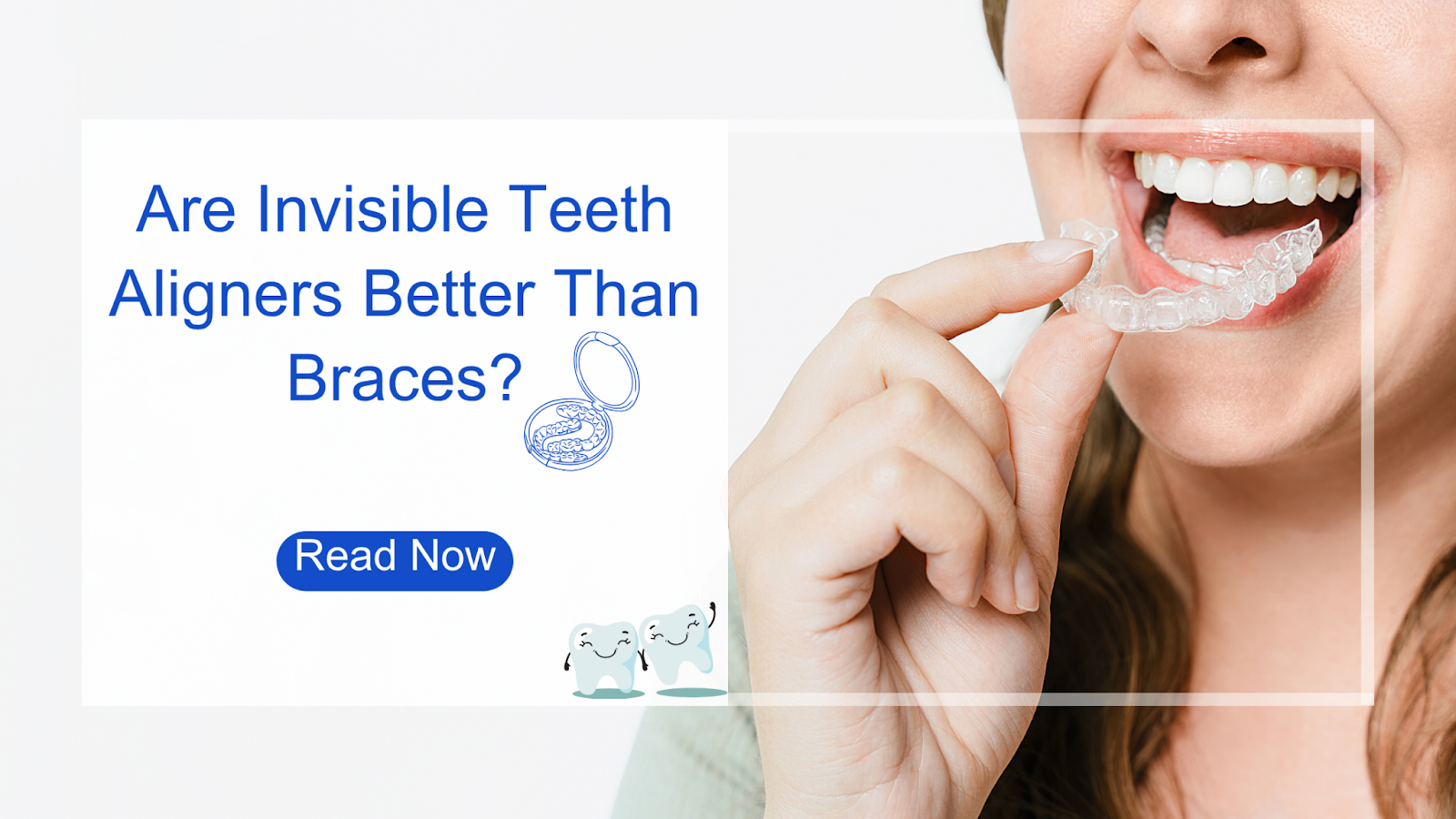When it comes to straightening teeth, dentists and orthodontists often have to guide patients through a big question: Are invisible teeth aligners better than braces? As more people seek comfortable, discreet, and effective ways to fix misaligned teeth, the debate gets louder.
With new technology, invisible aligners are now a strong option alongside traditional metal braces. But are aligners really better? Let’s understand it clearly so you can make the best decision for your patients.
What are Invisible Teeth Aligners?
Invisible teeth aligners, sometimes called clear aligners or invisible aligners, are custom-made, clear plastic trays designed to fit over teeth. Their main job is to slowly shift teeth into better positions using gentle, constant pressure. These trays get replaced every couple of weeks, each new set moving the teeth a bit more until things look just right.
Key Highlights:
- Practically invisible when worn
- Removable for eating and cleaning
- Custom-fitted for each patient
- Smooth, comfortable edges
Clear aligners, like those from Eledent Aligners, use advanced 3D scanning and planning to create precise treatment steps, ensuring predictable results for patients.
How Do Aligners Compare to Traditional Braces?
To help dentists and orthodontists guide patients, let’s look closely at how invisible aligners and braces stack up. We’ll compare them on comfort, looks, effectiveness, lifestyle, oral hygiene, and more.
Comfort: Do Aligners Feel Better?
Most people, and plenty of dental professionals, agree: invisible aligners are more comfortable than metal braces. Why? No wires or sharp metal brackets poking cheeks and gums.
How aligners win:
- No poking wires: Just smooth plastic.
- Less mouth irritation: Especially helpful for younger patients.
- Easy to remove: Patients can take them out for meals or important events.
Yes, the first set of aligners may feel tight. Patients might notice mild soreness when switching to a new set, but this usually fades within days. In contrast, braces often create lasting soreness and can even cause painful mouth sores.
Appearance: Which Option is More Discreet?
A big reason people choose clear aligners: they’re almost invisible. Metal braces are easy to spot, often making patients (especially teens and adults with public-facing jobs) feel self-conscious.
Aligners stand out because:
- Clear material: Nearly disappears from a few feet away.
- No metal or colorful bands: Perfect for patients wanting a natural look.
- Better for photo ops and special occasions.
Many patients are more confident with aligners, smiling without feeling judged about their treatment.
Oral Hygiene: Which Is Easier to Keep Clean?
This is a significant area where aligners shine. Invisible aligners can be removed for brushing and flossing, something braces can’t do.
Why this matters:
- Easier to clean teeth and gums
- Less build-up of plaque and food
- Fewer cavities and gum problems during treatment
With braces, it’s tough to brush and floss well around brackets and wires, raising the risk of white spots or decay by the end of treatment.
Diet and Lifestyle: Any Food Restrictions?
Ask any teenager with braces, and they’ll tell you: Say goodbye to popcorn, sticky candy, and chewing gum. Traditional braces often come with a long list of food restrictions.
With invisible aligners?
- Patients take them out before eating
- No food bans, patients can enjoy apples, nuts, and chewy foods
- No emergency dental visits for broken wires due to sticky snacks
Removable aligners allow patients to eat, play musical instruments, and even take photos, without showing metal in their smiles.
Effectiveness: Can Clear Aligners Handle All Cases?
Invisible teeth aligners are excellent for mild to moderate dental problems:
- Crooked teeth
- Gaps
- Slight overbites and underbites
- Crowding
For complex cases, like big jaw corrections, braces may still work better. Clear aligners depend on patient cooperation; they must be worn 20–22 hours every day for best results.
When cases get tricky:
- Severe rotations or large vertical movements
- Teeth that haven’t fully erupted
- Some jaw and bite alignment problems
In these situations, traditional braces can provide more precise control. Always review each patient’s needs and set realistic expectations.
Time and Appointments: Who Straightens Teeth Faster?
Treatment time matters, especially when kids and adults want quick results.
According to experts:
- Invisible teeth aligners: Average 6 to 18 months
- Traditional braces: Often 18 months to 3 years for tough cases
Aligner treatment is usually shorter for simple issues, but can match braces for more challenging problems. Fewer office visits are needed, too, patients often only come in to pick up new trays, or for check-ins instead of frequent adjustments.
Cost: What’s the Better Investment?
Most patients want straight teeth, without emptying their wallets. Here’s what you and your patients need to consider:
- Clear aligners usually cost a bit more than braces, especially if replacement trays are needed.
- Fewer emergencies and appointments can make aligners more convenient.
- Every case is different: each smile is different, and costs depend on the number of aligners, tooth movements, and compliance.
When Should Dentists Recommend Invisible Aligners?
Dentists and orthodontists must assess each patient carefully before choosing. Recommend invisible aligners when:
- Patients want discreet, removable straightening tools
- There’s a commitment to wearing aligners as directed
- Oral hygiene is a top priority
- The patient’s malocclusion is mild to moderate
Encourage conversations with patients about their lifestyle, budget, treatment goals, and ability to follow instructions.
You can find more clinical explanations and patient experiences with clear aligners on Eledent Aligners’ website, under the “Treatable Cases” section.
Clear Aligners: Real-Life Tips and Observations
- Some younger patients lose their aligners. Suggest dedicated cases and reminders.
- Compliance is vital. If patients won’t wear the trays as prescribed, teeth won’t move as planned.
- Unlike braces, aligners may be removed during sports or music performances.
- No “brace emergencies” such as broken brackets or wires sticking out.
- Most patients, even adults, quickly get used to the trays and appreciate the freedom.
FAQs on Invisible Teeth Aligners vs Braces
Q1: Can invisible teeth aligners treat all orthodontic problems?
A1: No. Aligners are best for mild and moderate issues. Severe bite problems may still need braces.
Q2: Are aligners more painful than braces?
A2: Most people find aligners more comfortable. Both may cause mild soreness when teeth shift, but aligners don’t have metal rubbing on gums and lips.
Q3: How often should patients see their orthodontist during aligner treatment?
A3: Usually less often than with braces. Appointments are mostly for progress checks and new trays.
Q4: Can young kids use invisible aligners?
A4: Aligners are often best for older children and adults who can handle the responsibility of wearing and caring for them.
Q5: Are invisible aligners hard to clean?
A5: Not at all. Patients just rinse them and brush gently when cleaning their teeth.
Conclusion: Making the Best Choice With Eledent Aligners
In many ways, invisible teeth aligners make life easier for both dentists and patients. They’re comfortable, nearly invisible, promote better oral health, and fit busy lifestyles. Of course, they’re not the answer for every patient or every dental problem. A dentist or orthodontist’s experience, matched with a patient’s commitment, makes all the difference.
Ready to explore if invisible aligners are your best next step?
Learn more about Eledent Aligners’ clear teeth aligners and see how you can offer your patients a modern, comfortable treatment option. Visit the Eledent Aligners website for detailed case examples and treatment planning tips.
Give your patients one more reason to smile confidently!


